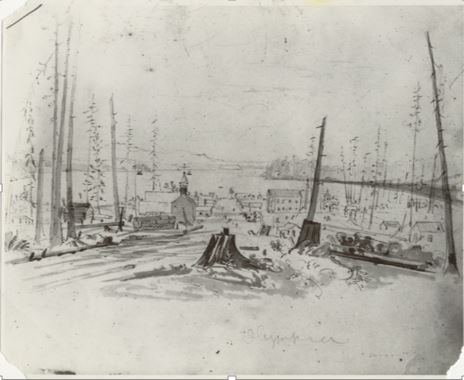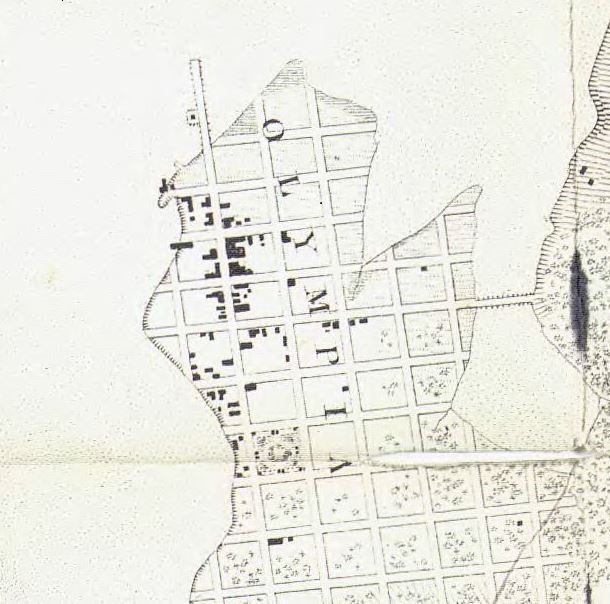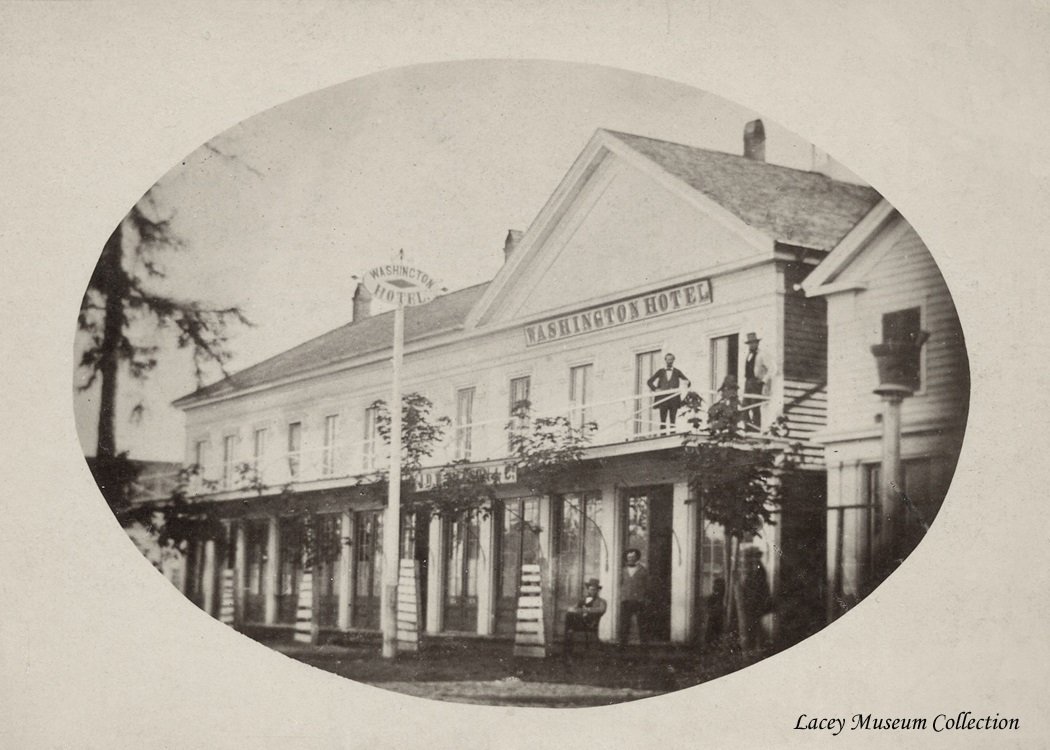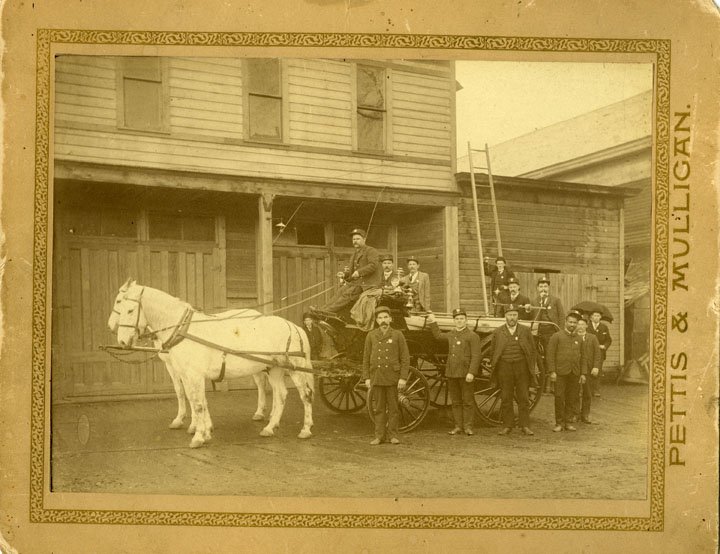It Happened Here
It Happened Here, installed in the historic 1912 City Hall/Fire Station in downtown Olympia at the corner of State Avenue and Capitol Way.
It Happened Here is an installation of images that document the various people and groups who used the land and buildings located at State Avenue and Capitol Way, downtown Olympia. It is located in the windows of the 1912 City Hall/ Fire Station that face State Avenue. The project was initiated by the Olympia Arts & Heritage Alliance and funded, in part, by the Downtown Olympia Alliance.
This webpage offers information what the images incorporated into It Happened Here depict. It also documents other events and people connected with this site throughout history.
Cecelia Pell Bob dry smoking cockle clams. Image courtesy of the Squaxin Island Tribe.
Native People were the first residents of Olympia. According to the Squaxin Island Tribe, “The old Squaxin village Steh-Chass is in present day Olympia. Another Squaxin ancestral site in the vicinity of Steh-Chass was called bəsčətxwəd, a Lushootseed name, meaning ‘frequented by Black Bears.’” Native people did not go away after the first Euro-American settlement in Olympia in the 1840s but continued to be part of the community as they are today.
For more information about the Squaxin Island tribe and culture see: https://squaxinislandmuseum.org.
“Olympia, W. T.” Looking north on Main or Capitol Way, by Artist James Alden, 1857. WSHS 1932.93.17.
In the 1840s, early Euro-American Olympia settler Levi Smith had a cabin in the area. He recorded information such as the number of canoes in the inlet and interactions with Native Americans, including trading. An early name for Olympia was “Smithfield” or “Smithster,” which combined Smith’s name and Edmund Sylvester’s name, another early settler. Some record the peninsula as “Cheet Woot”- a rendezvous point where Native people dried and stored shellfish. Other settlers followed and by 1850 they named the area “Olympia.”
To read Levi Smith’s diary see: https://olympiahistory.org/tannis-levi-lathrop-smith/ Levi Lathrop Smith Diary. Yale Collection of Western Americana, Beinecke Rare Book and Manuscript Library.
Detail of U.S. Coast Survey Reconnaissance of Olympia Harbor, W. T., 1856 showing the original shoreline and buildings. Note the East Side bridge is shown but the West Side bridge is not yet built. Private Collection. To view the entire map see: https://www.historicalcharts.noaa.gov/image.php?filename=AR56-00-1856
Isaac Stevens, first Territorial Governor, with his wife Margaret and family, also lived nearby. Just down the street the first legislative meeting for the newly designated Washington Territory took place in 1854, near hotels and businesses. Likely, by the 1870s a livery stable was at this site, which was convenient to Percival Dock, later street car lines and main roads.
First legislative meeting site WSHS 1924.32.1. More information: Remembering WA’s first Territorial Legislature – From Our Corner
Moses Rice Tilley Livery Stable, Unknown photographer, 1800s, Susan Parish Collection, Southwest Regional Archives. To learn more about Moses Rice Tilley see: Tilley Family (masonicmemorialpark.com)
Gurney Cab & Transfer Co. WSHS 2015.0.84 (1891-1906)
“Pine Tree” Washington Hotel Olympia, 1858. The hotel was just north of the legislative meeting site, on what is now Capitol Way N. Pattison Collection 1996-011, Courtesy of the Lacey Museum. More about the Washington Hotel: Thorp Motors Building (north end)/first Masonic meeting place/Washington Hotel | Olympia Historical Society and Bigelow House Museum (olympiahistory.org)
Olympia’s fire department is often recognized as one of the first fire departments in Washington Territory, although originally Olympia’s fire services were known as “clubs.” Barnes Hook & Ladder, Columbia Fire Companies and the “Squilgees” all operated locally before becoming part of City government in 1902. An early fire station was located on Columbia Street. Later, in the 1860s, a City Hall and Fire Station were built on 4th Avenue and known as “Columbia Hall.”
Olympia Fire Company No. 2, ca. 1891 on Columbia Street, included the city’s first Black firefighter, Jesse Mars, at right. WSHS C1943.2x.44.
“Columbia Hall,” April 30, 1902, WSHS 1943.42.1400 Learn more about Columbia Hall here: Columbia Hall – 1/17/2021 | Olympia Historical Society and Bigelow House Museum (olympiahistory.org)
A significant early 20th century project was the “Carlyon Fill,” a large-scale dredging and filling around the Olympia peninsula that deepened the harbor channel and created more industrial land.
The fill extended Olympia by several blocks to the north, east and west. Fred Wiseman landing in Olympia, May 18, 1911, WSHS C2013.18.195. To learn more see: First Airfield – 5/22/22 | Olympia Historical Society and Bigelow House Museum (olympiahistory.org) and History Of Olympia's Shorelines - ThurstonTalk
After the turn of the 20th century, the city decided to build a new city hall and fire station. They erected a fine building at an important downtown corner near the Carlyon fill (now State Avenue and Capitol Way) and in proximity to the many lumber mills in the area, as well as Percival Dock. The 1912 building originally housed city offices, the fire department, the Chamber of Commerce, the city police and the town library, which was donated by the Woman’s Club of Olympia. The Carnegie Library was not built until 1914.
Official department photo illustrating one of two platoons, which served 24 hour shifts at this time period. Captain of this shift was Earl Weatherbie. Ca. 1940s, photographer unknown. State Archives. Learn more here: History of Olympia Fire Department | Olympia Historical Society and Bigelow House Museum (olympiahistory.org)
1912 Old City Hall and Fire Station, still located at the corner of State Avenue and Capitol Way. WSHS C1982.18.29.16
Barbara Greene was Olympia’s female firefighter in the 1980s in this building. Olympia Fire Department.
Amanda Benek Smith, Olympia’s first woman Mayor, 1953-1960, served here. Washington State Archives. Learn more here: Amanda Benek Smith – 11/14/21 | Olympia Historical Society and Bigelow House Museum (olympiahistory.org) and People in Public Service: Amanda Benek Smith, Olympia’s First Female Mayor - ThurstonTalk
Olympia City government moved out of the 1912 building in the 1960s and the Fire Department main station relocated to the east side of Olympia in the early 1990s. The Old City Hall and Fire Station, listed on the Olympia Heritage Register, was used for a number of years as the Family Support Center and the building now awaits a new chapter in its history to bring more community history to this corner.
















